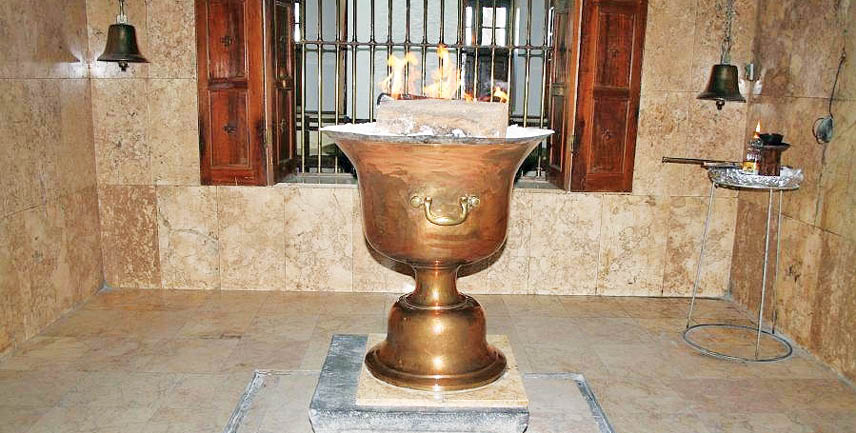.Myth No. 1: In the Zoroastrian funeral ceremony a dog is brought near the corpse to determine whether there is still any life left. Today with the advances in science, isn’t this a rather archaic diagnostic method? It is also believed that the dog shows the spiritual path to the soul.
Fact: The religious texts do not indicate anywhere that the dog is brought near the corpse to test whether the person is really dead or in a state of coma. Also, there is no indication in the scriptures that the dog shows the path to the soul for its onward journey into the spiritual world.
The term used in our religious texts is Sagdid. Sag means dog and did means sight. Therefore, the term literally means sight of the dog. The Vendidad asserts that the evil force of druj-e-nasu which emanates as a result of putridity retreats or is contained as a result of the energy that emanates from the eyes of a dog, especially a dog which has a spot over both eyes!
The myth regarding the dog showing the spiritual path to the soul probably traces its root to Sarosh Yazata being the guardian angel of all souls and the dog being His co-worker.
Even in the Mahabharata, the final chapter closes with a dog following the Pandavas on their final journey. It is disclosed later that the Divinity of Dharma (Divine Law and Order) had taken the form of a dog. In Vedic tradition, dogs are the guardians of the gates of heaven.
In ancient Egypt, dogs were associated with Anubis, the god of the underworld or after-life just as in ancient Greek mythology Cerberus was the three-faced guard dog of the Underworld. The Catholic Church recognizes Saint Roch (also called Saint Rocco), who lived in the early 14th century in France, as the patron saint of dogs. It is said that he caught the deadly plague while doing charitable work and went into the forest, expecting to die. There he was befriended by a dog who licked his sores and brought him food, and he was able to recover. The feast day of Saint Roch, August 16, is celebrated in Bolivia as the birthday of all dogs!
Myth No. 2: Is fire really the son of Ahura Mazda?
Fact: In the Atash Neyayesh or the litany to fire we address fires as Atash Puthra Ahurahe Mazdao. Some scholars interpret the term Puthra (Sanskrit Putra) as son. However, other scholars like Kavasji Edulji Kanga have derived the meaning of this word Puthra from the Sanskrit root ‘pu’ meaning to purify, to render pure, “source of purifying, cleaning” and have translated the term as “purifier”.
Thus, Kangaji translates Atash Puthra Ahurahe Mazdao as “O Fire, the purifier (of all things) pertaining to Ahura Mazda”.
Myth No. 3: There are special fires in Iran which can fly at will! True?
Fact: The ‘special’ fires that one keeps hearing about are preserved in certain sleepy little villages of Yezd. The desert province of Yezd, in Iran, is an ancient Zoroastrian stronghold. The fire that burns in the village of Sharifabad (Yezd) is said to be more than 2,000 years old.
The legendary ‘flying fires” have a charm that cannot be expressed in words. This is not to say that one can see them fly, though there are old-timers who claim to have seen them fly at night in the desert sky in the shape of a ‘Tir’ (arrow) or as others describe, ‘Tongue of fire’. Not much can be written about these special fires except to say that one must experience the mystic of these ancient fires rather than talk about them.
According to oral tradition, the Zoroastrians of Yezd believe that generations ago these special fires ‘flew’ into certain Zoroastrian villages like Cham, Zainabad, Taft, Mariamabad, etc. These special fires were typically found crackling and glowing on a cypress tree in the village.
One could rationalize that lightening may have struck the tree or the intense desert heat may have triggered a spontaneous fire. But there is no denying the fact that these fires have a natural origin. Over the decades devout ‘Atashband’ (keepers of the Holy Fire) have preserved these Fires with great devotion and piety. Several miracles and legends are associated with these fires.
Not too far from Iran is, Yanar Dag which means ‘burning mountain’. It is a natural gas fire that blazes continuously on a hillside on the Absheron Peninsula on the Caspian Sea near Baku, the capital of Azerbaijan – a country which itself is known as ‘the Land of Fire’.
Alexandre Dumas, during one of his visits to the area, described a similar fire he saw in the region inside one of the Zoroastrian fire temples built around it. Only a handful of fire-mountains exist today in the world, and most are located in Azerbaijan. Due to the large concentration of natural gas under the Absheron Peninsula, natural flames have burned there throughout antiquity and were reported by various travelers including Marco Polo.
may have heard, and which they would like clarified, as also your feedback to editor@parsi-times.com.
- Celebrating The Interplay Of Life And Fire! - 20 April2024
- Customs To Observe At Atash Behram Or Agyari - 13 April2024
- A Shower Of Spring Festivals - 6 April2024
